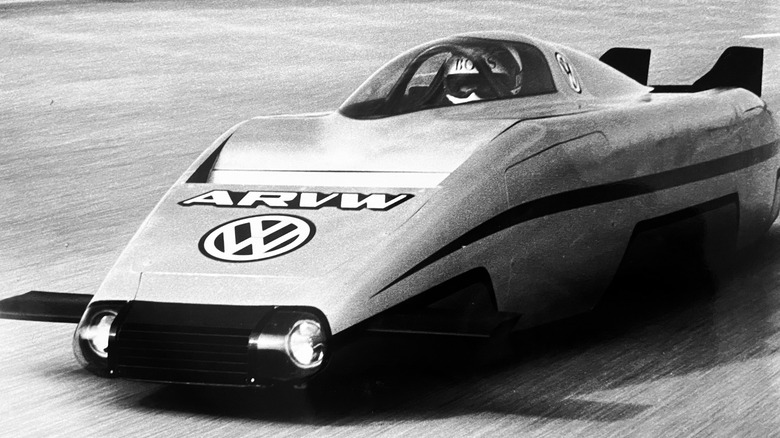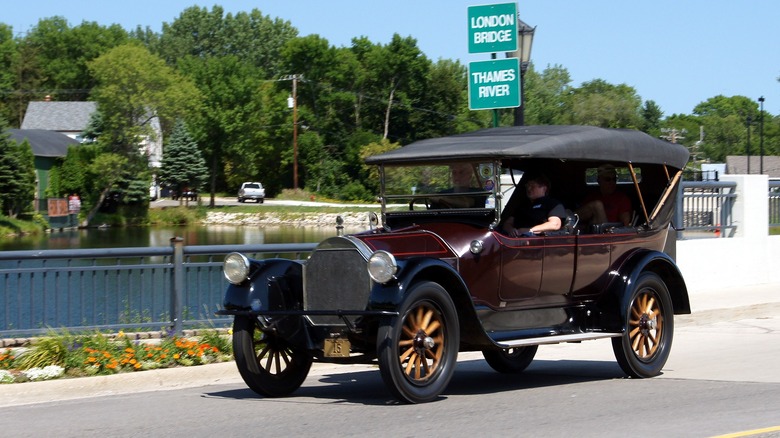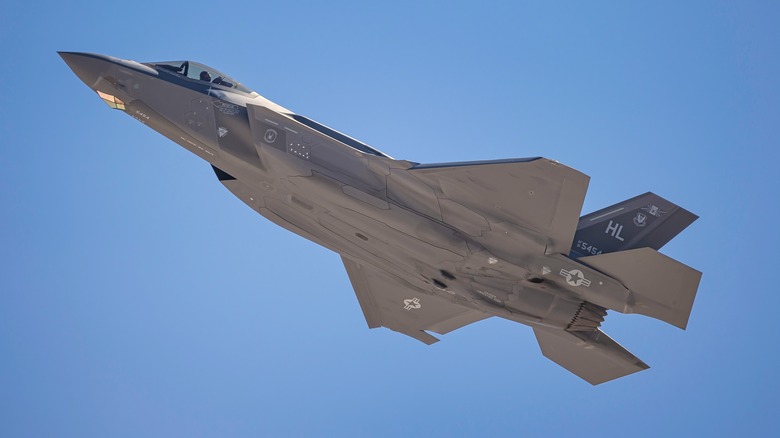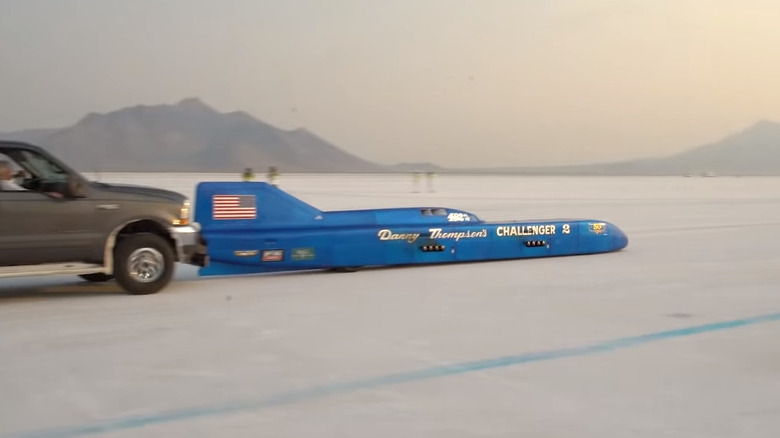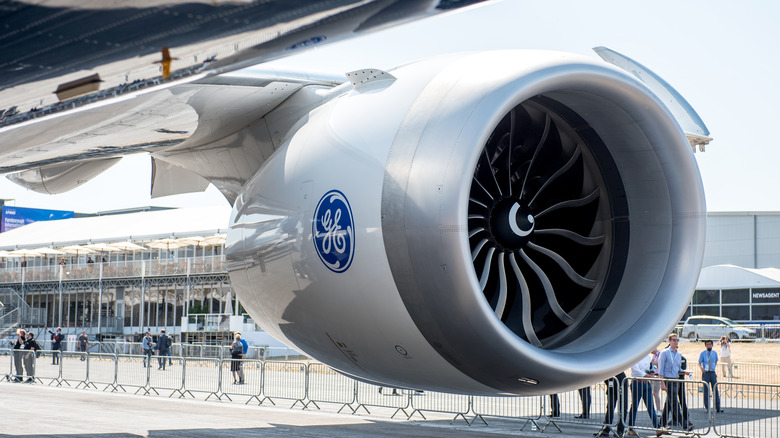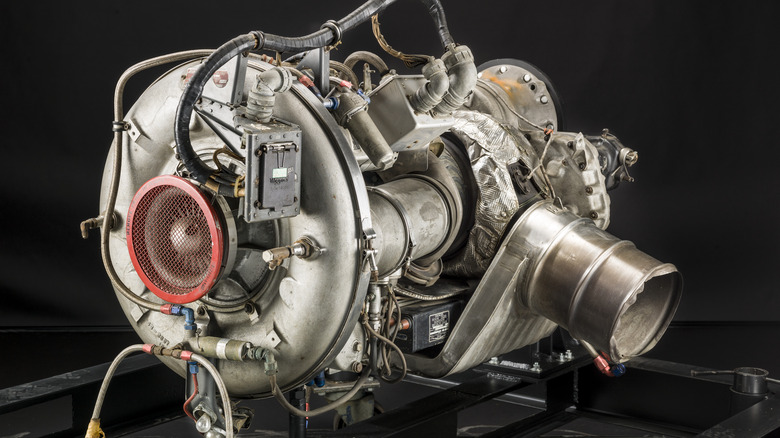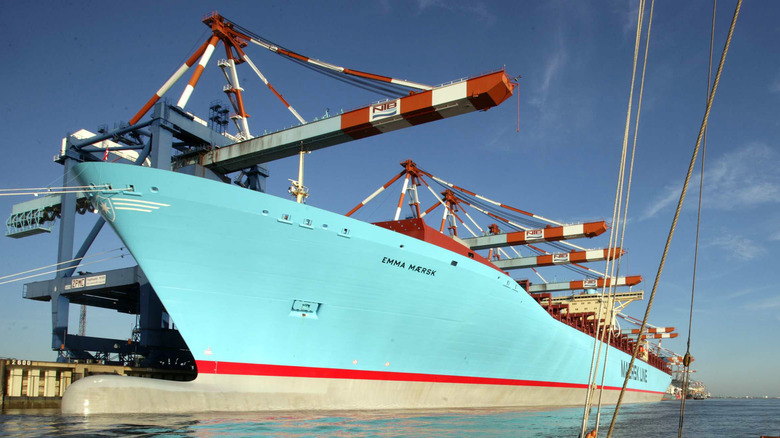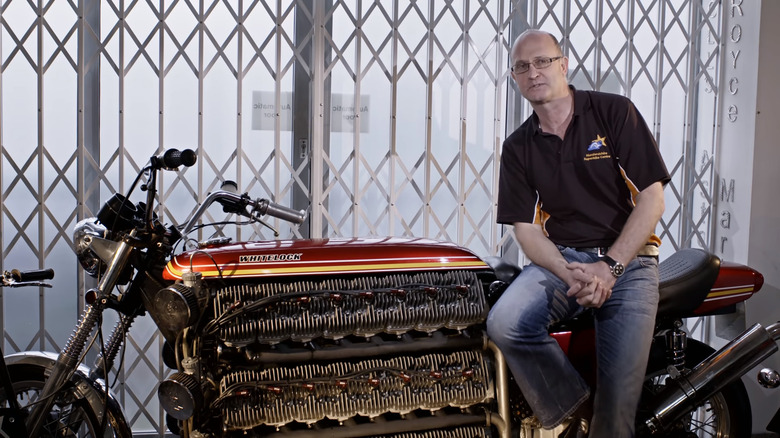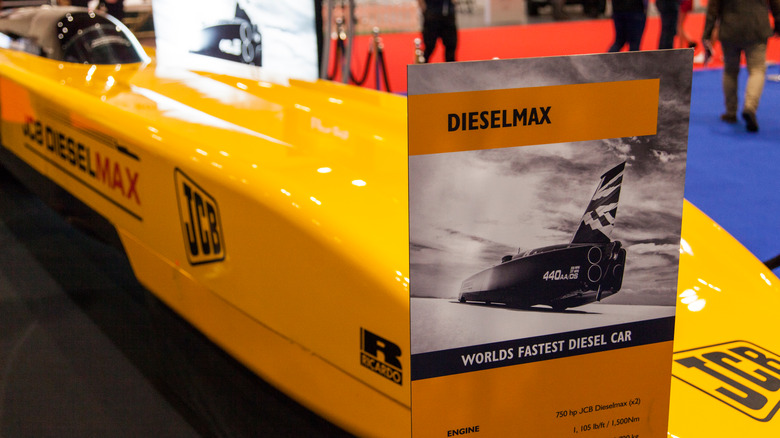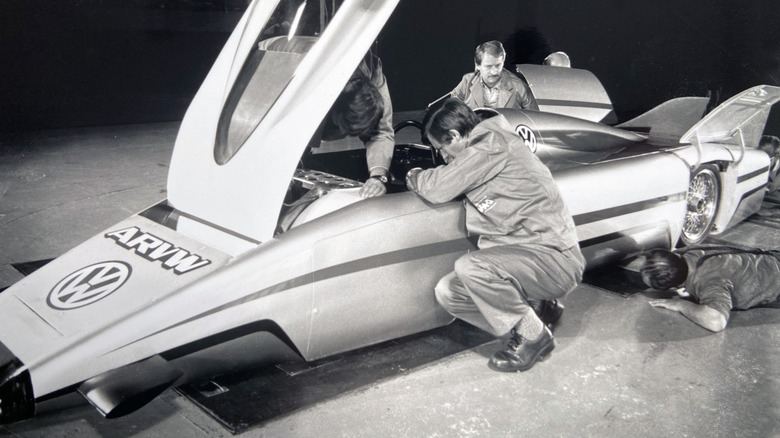10 Engines That Set Guinness World Records
As the world's de facto record adjudicator, Guinness World Records keeps tabs on all manner of weird and wonderful feats. Toyota's humanoid robot which happens to be really good at basketball is a Guinness World Record holder, alongside the man who delivered a Pizza Hut order to the top of Mount Kilimanjaro. And let's not forget the Guinness-certified giant mech suit that can crush cars and rip through jungles.
As well as being an excellent way to delve into strange stunts and weird machines, Guinness World Records are also a great way for companies and inventors to prove that they're the best in the world at what they do. This goes for engine manufacturers, too — from cutting-edge fighter jet engines to modified backhoe loader powerplants, there's a surprising record category for almost every type of engine. There's a long list of officially recognized feats that the world's most exceptional engines can lay claim to, but we've picked out a selection of the best.
Largest production car engine – 13.5L
In the early days of carmaking, engines were only a fraction as efficient as they are today. That meant that manufacturers looking to produce the most powerful vehicles often resorted to building huge engines, with the largest of those being the 13.5L six-cylinder engine that featured in the Pierce-Arrow Model 66, Faegol, and Peerless 6-60, which were produced between 1912 and 1918. The engine generated around 66 horsepower, a highly impressive figure for its day, even if it's dwarfed by modern outputs.
While Guinness World Records acknowledges the 13.5L engine as the largest to be put into a production car, it's not the largest to ever feature in an automobile. The infamous Fiat S76, or "Beast of Turin," featured a 28.4L four-cylinder engine, and was recently restored by a collector after decades of neglect. However, the Beast of Turin was only ever built as an experimental race car, and so it doesn't qualify for the official record.
[Featured image by Greg Gjerdingen via Wikimedia Commons | Cropped and scaled | CC BY 2.0]
Most powerful fighter jet engine – 28,800 lb thrust
The world's greatest fighter jets are only as great as the engines that propel them, and the most powerful of all according to Guinness World Records is that fitted to the F-35A Lightning II Joint Strike Fighter. It's made by Pratt and Whitney and is officially rated to produce 28,800 lb thrust in intermediate power, rising to 43,010 lb at full power. The F35A is considered to be the world's most advanced fighter jet and was created to replace both the United States' and its Allies' aircraft, many of which were more than two decades old at the time the program was commissioned.
Replacing the fleet has proven to be extremely expensive, but the aim is to recoup some of that cost over time, as the F35A is designed to require considerably less maintenance than older jets. That includes the engine, of which there is only one on each plane — not only is it the most powerful jet of its kind, but it's designed to be among the most reliable, too.
Fastest piston-engined car – 448.757 mph
It might not have reached the astonishing speeds set by the world's fastest car, Thrust SSC, but the story behind the world's fastest piston-engined car is just as remarkable. The vehicle used to set the record, Challenger 2, was first built in 1968 by Mickey Thompson. It was the successor to his original Challenger vehicle, which had tried and failed to set a new record a few years earlier. The second attempt had attracted some big-name sponsors, including Ford. However, unusually high levels of rain at Bonneville that year meant Thompson never got the chance to test the car, and sponsors eventually lost interest and withdrew funding for the project.
Two decades later, Mickey took the car out of storage and was attempting to prepare for a second try for the record, but was tragically killed before an attempt could take place. It would take another 30 years for Mickey's son, Danny Thompson, to resurrect the project, eventually setting the record of 448.757 mph at Bonneville in 2018. Originally, the Challenger 2's engine setup consisted of two Ford 427 V8s, but for the 2018 run, Danny Thompson replaced them with Chrysler Hemi V8s. The pair made around 5,000 horsepower in total. After setting the record, Thompson placed the vehicle up for auction, where it sold for $561,000.
First 3D printed jet engine – General Electric
Industrial uses for 3D printing are constantly expanding, from 3D printing a bridge in Amsterdam to changing the food industry by 3D printing vegan steaks. This is no new phenomenon — back in 2016, General Electric achieved official Guinness World Record recognition for its 3D printed jet engine, which was the first of its kind. The engine, described by GWR as roughly the size of a backpack, was a custom design, as General Electric's engineers decided that the manufacturer's production engines would be too complicated to reproduce.
It's also noted in the record entry that although every part was 3D printed, some "finishing touches" were carried out by hand. The initial prototype formed part of a larger project, with the ultimate goal of using 3D printing to manufacture parts for commercial jet engines. Printing using the kind of metal alloys needed for jet engine construction is still an emerging technology, although General Electric has already developed FAA-approved printed parts for limited use in commercial jets.
First turbine-engined helicopter – Kaman K-225
Kaman Helicopter Company developed the K-225 as a crop duster, first releasing the model in 1949. In 1951, Kaman replaced the engine on one of its K-225 prototypes with a Boeing 502-2 gas turbine engine, in a bid to prove to the U.S. Navy that the technology had potential. The new turbine was considerably lighter than previous engines, and the Navy eventually commissioned a series of military helicopters that utilized the new setup.
The original prototype took its maiden flight on December 11, 1951, earning a Guinness World Record in the process. There was more than just a record riding on the success of the aircraft: The entire Kaman company was on the verge of bankruptcy and needed the Navy contract as a lifeline. Kaman continued to co-develop the turbine-powered helicopter along with the Navy in the following years, eventually giving rise to what would become the modern helicopter turbine engine that powers many rotary-winged aircraft today.
Smallest steam engine – six microns wide
The world's smallest steam engine is almost unfathomably tiny, with its piston measuring just six microns wide and two microns high. It was developed in 1993 by Sandia National Laboratories, with the New York Times reporting that the engine was created by using cutting-edge computer chip manufacturing technologies.
The engine works much the same way as a larger steam engine does: a heating element turns water to steam, pushing the single piston outwards and compressing a spring. When the heater is turned off again, the piston reverts to its original position and the spring expands again. The team envisioned a range of uses for the engine, including using it to activate microscopic tweezers during delicate surgical operations and positioning electronic components with extreme accuracy during the manufacturing process. However, much of the development around micro steam engines is still in the research stage, with few practical uses found for now.
Largest marine engine – 88 feet 7 inches long
The Wärtsilä RT-flex96C is not only the largest marine engine, but also the largest commercial engine of any kind, according to Guinness World Records. It measures 88 feet 7 inches in length and 44 feet 4 inches in height, and generates 114,800 horsepower in its most powerful form. It powers several of the world's largest ships, including the MV Emma Maersk, which at the time of its launch, was the largest container ship in the world. As well as being more powerful than its predecessors, the engine is designed to cut down on the amount of carbon emissions generated, as well as the amount of fuel it consumes.
Apart from its huge size, its most unique feature is its 14-cylinder layout — most ship engines had no more than 12 cylinders at the time of its release. The design was based on a 12-cylinder engine that was already in service, but featured extra reinforcements to compensate for the additional stresses caused by the two further cylinders.
Vehicle engine with the most cylinders – 48 cylinders
A 14-cylinder ship engine might be unusual, but it's a long way off the official record for the engine with the most cylinders. That rather odd title instead goes to an English inventor called Simon Whitelock, who created a one-off Kawasaki with a 48-cylinder engine. It was, according to Whitelock, not for any performance or practical purpose. Instead, it was simply created as a record-breaking show bike, and it certainly does make a show.
The comically oversized engine is made up of 16 Kawasaki three-cylinder engines fused together, with a laundry list of custom-fabricated parts to get the whole thing working. The bike itself, although extremely stretched, can still fit a rider, with Whitlock being just about able to reach the handlebars when sat in the saddle. However, it has reportedly never been ridden, and considering its unusual shape and huge power, would be extremely dangerous were anyone foolish enough to have a go. It was listed for sale in 2011 with a starting bid of £500,000 and a buy-it-now price of £1 million (roughly $1.6 million), but unsurprisingly, didn't attract any buyers.
Fastest diesel-engined car – 350.092 mph
The driver of the world's fastest car, former RAF fighter pilot Andy Green, also holds the record for the world's fastest diesel car, set nearly 10 years after his famous Thrust SSC run. The JCB Dieselmax reached a recorded speed of 350.092 mph at the Bonneville Salt Flats on August 23, 2006. Green actually broke the record twice, setting a record of 328.767 mph the day before. The engines powering the car were two modified JCB444-LSR engines, a variant of the JCB444 engine that's more commonly found in tractors and plant vehicles.
The record attempt was backed by the boss of JCB, Sir Anthony Bamford, as a way to show off the versatility of the brand's latest engines. It did just that, breaking the record by around 100 mph, and in such a decisive fashion that no other competitors have attempted to break it in the years since.
Farthest distance driven by an internal combustion engine in one hour – 219.598 miles
Setting a speed record over a flying mile is one thing, but keeping a consistent high speed up for an hour is an entirely different engineering challenge. VW currently holds the record with its experimental ARVW prototype, which managed 219.598 miles over the course of an hour at the Nardo circuit in 1980. It was created as a design exercise for VW's development team, with the oil crisis of the '70s sparking renewed interest in optimizing aerodynamics instead of simply adding larger, more powerful engines.
VW claims the car is still the most aerodynamic vehicle it has ever built, with a drag coefficient of just 0.15. Evidently, the design was very effective, as, despite its top speed of more than 220 mph, the car's 2.4L six-cylinder engine could only produce 177 horsepower. That makes the ARVW one of the least powerful cars to ever reach 200 mph. Although VW never made a production car quite as radical as the ARVW, the limited-run XL1 copied many of its design cues when it was unveiled in production form around a decade ago.
